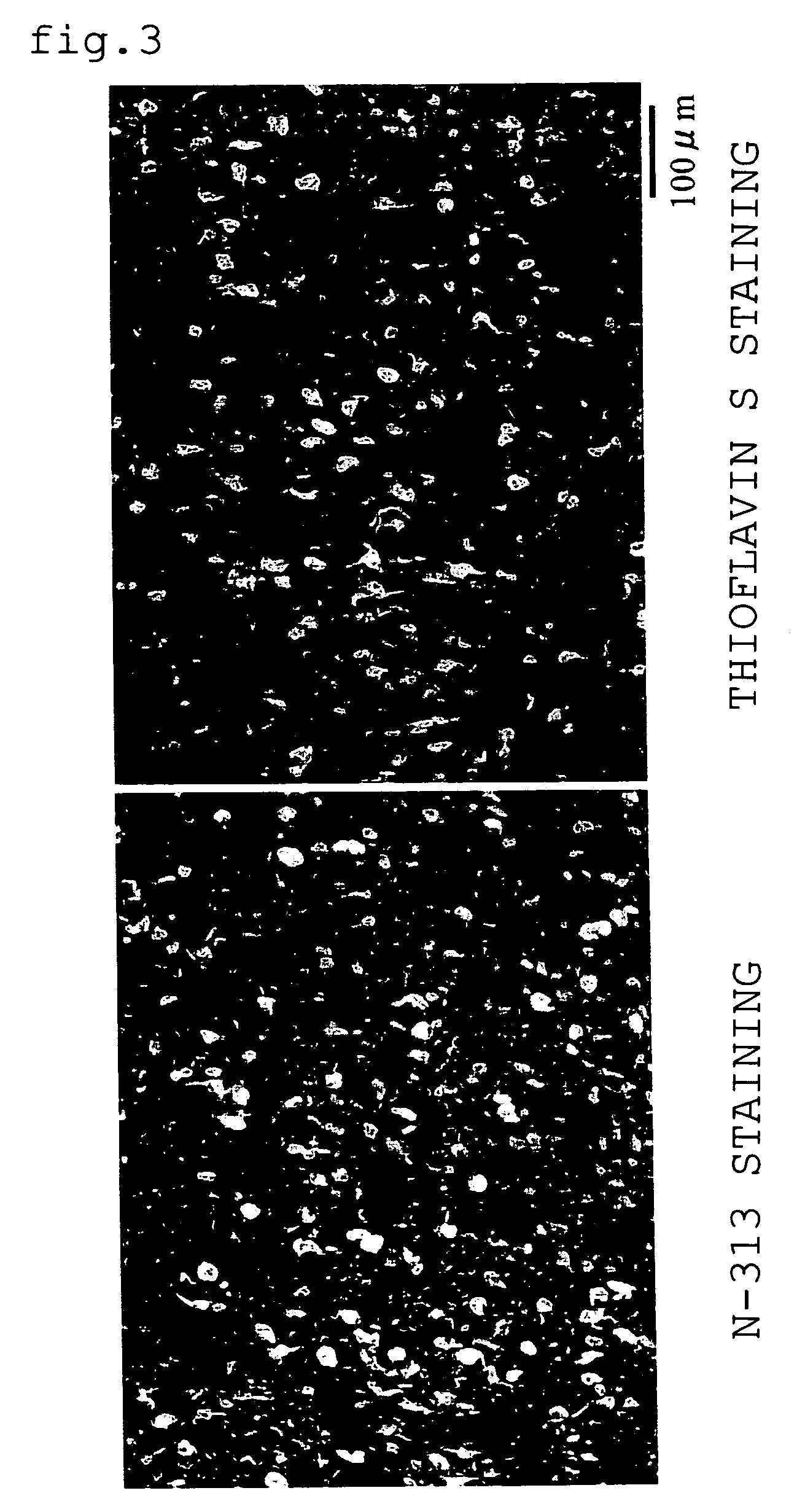Quinoline derivative as diagnostic probe for disease with tau protein accumulation
a technology of tau protein and quinoline derivative, which is applied in the field of diagnostic probes for diseases with tau protein accumulation, can solve the problems of high patient cost, high cost of patients, and difficulty in making an accurate diagnosis of alzheimer's disease at these stages
- Summary
- Abstract
- Description
- Claims
- Application Information
AI Technical Summary
Benefits of technology
Problems solved by technology
Method used
Image
Examples
example 1
The Inventive Compounds are Compounds which Specifically Recognize Tau Protein
[0121]According to the above-described method for screening compounds which specifically recognize tau, we have found BF-158, BF-170, N-310, and N-313 as compounds which are particularly preferred. The results are shown in FIGS. 1 to 9. For the structure of the test compounds, see Table 1.
[0122]As shown in FIGS. 1 and 2, N-310 (left panel) displayed staining properties similar to those of thioflavin S (right panel, an adjacent section of the left panel's section), in hippocampus sections of the brain of a patient with Alzheimer's disease. Like thioflavin S, N-310 stained neurofibrillary tangles (or phosphorylated tau protein).
[0123]As shown in FIGS. 3 and 4, N-313 (left panel) also displayed staining properties similar to those of thioflavin S (right panel, an adjacent section of the left panel's section), in hippocampus sections of the brain of a patient with Alzheimer's disease. Like thioflavin S, N-313 ...
example 2
Acute Toxicity testing
[0130]Next, BF-170, BF-158, and N-313 were examined by the procedures for testing of acute toxicity as described above in (A) and yielded the results as shown in Table 2 below.
[0131]
TABLE 2Results of acute toxicity testingMaximum Tolerated DoseCompound(mg / kg, intravenous administration)BF-170≧10BF-158≧10N-313≧10
[0132]For PET imaging in humans, in general, total doses of administration of a positron label and an unlabeled compound utilize intravenous administrations ranging from 1×10−12 to 1×10−5 mg / kg, and often from 1×10−10 to 1×10−7 mg / kg. When the comparison is made between the maximum tolerated dose upon intravenous administration of these compounds and the total amount of compounds required for PET imaging, there are at least more than 1,000,000 times and more than 100,000 times differences between both of these compounds, and therefore the inventive compounds are likely to be compounds which have extremely high levels of safety as probes for PET imaging.
example 3
Blood-brain Barrier Permeability
[0133]Table 3 shows the permeability of the test compounds into the brain in mice two minutes after intravenous administration. Testing procedures followed the method described above in (B). With regard to blood-brain barrier permeability of compounds for PET or SPECT whose target is the central nervous system, it is believed that values of 0.5% ID / g or higher would be sufficient. In that sense, BF-170, BF-158, N-313, and N-313 are compounds having extremely high levels of blood-brain barrier permeability.
[0134]
TABLE 3Blood-brain barrier permeability of the testcompounds two minutes after intravenous administration (mice)% ID / g or mlCompoundBrainPlasmaBF-1709.11.4BF-1589.71.8N-31015.01.0N-3134.61.1
[0135]As conventional agents for staining brain sections of patients with Alzheimer's disease, mainly Congo red or thioflavin S has been used. These staining agents are characterized by staining both senile plaques and neurofibrillary tangles, which are said...
PUM
| Property | Measurement | Unit |
|---|---|---|
| weight | aaaaa | aaaaa |
| weight | aaaaa | aaaaa |
| weight | aaaaa | aaaaa |
Abstract
Description
Claims
Application Information
 Login to View More
Login to View More - R&D
- Intellectual Property
- Life Sciences
- Materials
- Tech Scout
- Unparalleled Data Quality
- Higher Quality Content
- 60% Fewer Hallucinations
Browse by: Latest US Patents, China's latest patents, Technical Efficacy Thesaurus, Application Domain, Technology Topic, Popular Technical Reports.
© 2025 PatSnap. All rights reserved.Legal|Privacy policy|Modern Slavery Act Transparency Statement|Sitemap|About US| Contact US: help@patsnap.com



